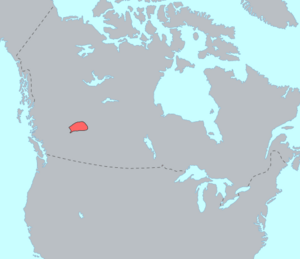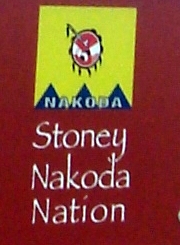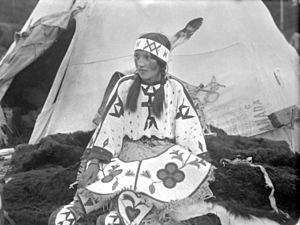Nakoda people facts for kids

The Nakoda people, also known as Stoney or Îyârhe Nakoda, are an Indigenous group living in Western Canada. They originally lived in parts of the United States too.
Long ago, they lived in large areas of what is now Alberta, Saskatchewan, and Montana. Today, their special lands, called reserves, are mainly in Alberta and Saskatchewan. In Saskatchewan, they are often seen as very similar to the Assiniboine people. The Nakoda are related to the Dakota and Lakota nations through their language. These groups are all part of the larger Sioux Nation, found across the Great Plains and Rocky Mountains.
In their own language, they call themselves "Nakoda", which means friend or ally. The name "Stoney" was given to them by early European explorers. This name came from their clever way of cooking. They would heat rocks in a fire and then drop them into rawhide bowls to boil broth. They are very close to the Assiniboine people, who are also sometimes called Stone Sioux.
In Alberta, the Nakoda First Nation includes three main groups or "bands": Bearspaw, Chiniki, and Wesley.
The Stoney people were not allowed in Banff National Park between 1890 and 1920. However, in 2010, they were officially welcomed back to the park.
Who Are the Nakoda (Stoney) People?
The Stoney people are descendants of different groups from the Sioux Nation, including the Dakota, Lakota, and Nakota. They are especially linked to the western groups of the Assiniboine. The Stoney became their own separate group around 1744.
The Stoney people are divided into two main groups based on where they lived and how they spoke. These groups also have smaller bands within them:
Wood Stoney (Chan Tonga Nakoda – ‘Big Woods People’)
- Alexis' band (This band includes Stoney, Métis, and Woodland Cree people.)
- Paul's band (This band includes Danezaa, Stoney, Woodland Cree, and Iroquois people.)
Mountain Stoney (Ye Xa Yabine Nakoda or Hebina – ‘Rock Mountain People’)
- Sharphead's band (Chipos Ostikwan's Nakoda, also known as Wolf Creek Stoney or Pigeon Lake Stoney). This band includes Stoney and Métis people.
- Stoney Nakoda First Nation: This nation is made up of three bands:
- Wesley's (Goodstoney's) band (Includes Stoney, Plains Cree, and Métis people.)
- Chiniki's band (Includes Métis, Stoney, and Plains Cree people.)
- Bearspaw's band (Includes Stoney and Cree people.)
Important Agreements: Treaties
Treaties are special agreements between different nations or groups of people. Members of the Nakoda nations from Paul and Alexis signed an agreement to join Treaty 6 in 1877.
Also in 1877, leaders from the Nakoda Nations of Bearspaw, Chiniki, and Wesley met with representatives of the British Crown. The British Crown represents the government of the United Kingdom, and these agreements were made in the name of Queen Victoria. They talked about the terms of Treaty 7.
In exchange for allowing others to use their traditional lands, the British Crown agreed to respect the Nakoda people's right to govern themselves and continue their traditional way of life. They were also promised special lands called reserves. These lands covered about 279 square kilometers (about 108 square miles) along the Bow River, between the Kananaskis River and the Ghost River. These areas became the Big Horn, Stoney, and Eden Valley reserves. These lands are shared by the Bearspaw, Chiniki, and Wesley tribes.




